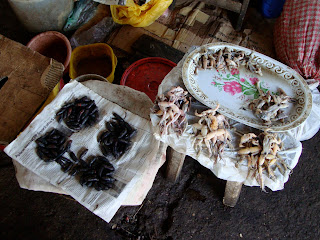The Smith family and their au pair (that’s me) are back on the road in a cloud of moose milk! Last Saturday Jordan, Niva and I left San Jose, Costa Rica destined for Lima, Peru. I actually did some research this time, and couldn’t wait to dive into Peru’s famous cuisine. Our first night in Lima I inhaled some causa limeña. They are a typical dish of Lima, consisting of some sort of fish in a delicious sauce. In short, I would compare them to a gourmet version of a western “tuna or chicken salad”. I had a combo of 3, each mindfully placed upon a circular bed of boiled potatoes, one of Peru’s 200 varieties. From what I could decipher, one was a squid based salad in a black olive crème sauce. Another, tuna (gulp, not a sustainable choice) with avocado and pepper, and finally a whitefish in a pink saffron infused crème. All were delicious and left me wanting more.
After our night in Lima we were headed to Puerto Maldonato, a lazy, hot jungle town in Southeastern Peru which rests on the banks of the Madre de Dios River, literally meaning “the river of the mother of God”. When we weren’t wiping sweat or dodging the countless swarms of Mototaxis, Niva and I enjoyed exploring the town’s small market or cooling off in our hotel’s pool. Niva, being the adorable 15 month old she is, didn’t need a swimsuit during our short dip. She did, however, use her sign language to tell me she was about the relieve herself on the pool deck, and well, she wasn’t kidding! I can now add to my list of nanny experiences that yes, I’ve picked up warm, fresh caca off a pool deck in the middle of the Amazon and deposited in the appropriately labeled “organic” bin. Think this is just a food blog? Think again. What goes in must come out!
Our next destination was the famous Cuzco, from where I write this blog. Cusco is the historic capitol of the Incan empire, and sits at 12,000 ft in the middle of the Andes. It’s chilly here, but I am warmed hearing the locals speak Quechua and by admiring the beautiful Incan and Colonial architecture. We were given some guidelines upon arriving to help curb the altitude sickness: don’t eat too much (ya right) and rest often (not a problem). CAVU’s (cavuussite.org) right hand man/friend of mine Dave Sherwood (http://wildfilephoto.com/index.php?x=about ) and I needed a “light snack” upon arrival on Tuesday. After deciding that 2 full entrees were not enough, we added a plate of chicerones to our order. After polishing off the deep fried meat with unknown origins, I dove into my plate of llama. Tough and rubbery at first, it’s deep and fresh flavors captured me immediately and I couldn’t help but finish the entire plate. Dave ordered some local trout which was also delicious. Fortunately, the altitude did not affect my digestion, and I was well on my way to fueling my quixotic appetite.
After a light breakfast at our hotel on Wednesday, I made my way towards the local central market. Passing by the beautiful Plaza de Armas, I wasn’t sure exactly what I’d be getting myself into. It turned out to be one big, giant tease of culinary heaven.
There’s not much that couldn’t be found at the market: fruits, vegetables, cheese, giant round discs of bread each boasting their own unique design, grains (including Peru’s famous quinoa), meats, handicrafts, fish, algae, olives, spices, shoe shiners, seamstresses, local cuisine, you name it. I’d like to expand my description of the meat section. Here, my zoology and anatomy courses came in handy. Not only did you see the usual cuts of thigh and shoulder, you may also purchase cow and pig heads, hearts, lungs, livers, intestines, stomachs, and small plastic bags of an unknown intestinal juice, all hung about in dishabille. I also dodged some frogs leaping for their lives out of a small plastic bin, wearily eying their former brothers and sisters lying skinned on a platter next to them. There were entire pigs for sale, and through a combination of my bad Spanish comprehension and the woman’s heavy accent, and I unable to decipher the price of the entire hog.
I had some wonderful cultural exchanges as well. I arrived around 11 am, which seemed to be during the vendors “pre-lunch siesta”. A local woman and I exchanged chuckles and she struggled to awake a snoring woman selling herbs. I purchased some cumin seeds, which are hard to find in Costa Rica for some reason, and also some local herbs to aid in digestion. The woman was quite annoyed after the third time I asked her to repeat its name, and I still don’t remember! I smiled at a tiny Peruvian girl, clad in her Alpaca sweater and hat, being drug around in a plastic produce basket. I longed to plunge my hands deep into the burlap sacs of corn, quinoa, and grain, but resisted in fear of being pelted with slimy frog carcasses.
So far I am quite impressed with Peru. The people are friendly, the cuisine is surprising, and the weather is a much welcomed change from the constant heat and rain of a Costa Rican July. I really dig the locals constantly saying “ya” in agreement with my restaurant orders, etc. It almost sounds like someone from northern Wisconsin or Minnesota.. just like home.
More to come soon. Pictures, Machu Picchu, guinea pigs, and more pisco sours are in the works. I am so blessed to be here and can’t wait to share more of my experiences.












